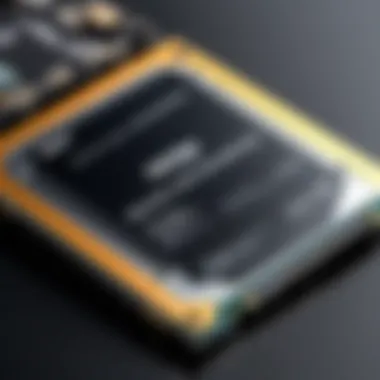Understanding SSD Drive Sizes for Optimal Performance


Intro
As the demand for high-performance computing increases, understanding the specifications of Solid State Drives (SSDs) becomes crucial. SSDs have transformed data storage through speed and reliability compared to traditional hard drives. However, the choice of SSD size can have significant implications on system performance, efficiency in storage management, and user experience.
This article aims to provide clarity on SSD drive sizes. By analyzing various capacities and their specific roles in computing environments, it becomes easier for IT professionals to make informed decisions. Additionally, we will explore the various features and performance metrics associated with different SSD sizes.
The following sections detail the key specifications and unique selling points of SSDs, followed by a thorough performance analysis that includes benchmarking results and insights from real-world scenarios. This comprehensive guide is designed to equip professionals with a deeper understanding of SSD technology and its impact on modern computing.
Prelude to SSD Drives
The increasing reliance on digital storage necessitates a thorough understanding of Solid State Drives (SSDs). As the backbone of modern computing, SSDs enable faster access to data compared to traditional hard drives. Their significance extends beyond speed; they influence overall system performance, reliability, and storage management practices. In this section, we will explore the definition and functionality of SSDs and the various types available today.
Definition and Functionality
SSDs are storage devices that use flash memory to store data. Unlike Hard Disk Drives (HDDs), SSDs have no moving parts, which contributes to their speed and durability. Data is stored in microchips, allowing for instant access rather than waiting for a physical read/write head to move over a spinning disk. This key difference in technology allows SSDs to provide lower latency, reduced boot time, and quicker file transfers.
Furthermore, the absence of moving components makes SSDs more resistant to physical shock, enhancing their reliability in mobile and portable computing scenarios. These attributes make them preferable for a range of applications, from personal laptops to enterprise-level servers.
Types of SSDs
There are several types of SSDs available, catering to different use cases and demands. Each type serves a unique purpose and offers varying levels of performance, capacity, and compatibility.
- SATA SSDs: These are the most common type of SSDs, using the same interface as traditional HDDs. While they provide significant speed advantages over HDDs, their performance is limited compared to other types.
- NVMe SSDs: Non-Volatile Memory Express drives offer faster data transfer speeds than SATA SSDs. They connect directly to the motherboard via the PCIe interface, allowing for improved performance in data-intensive applications.
- M.2 SSDs: These compact SSDs are designed primarily for laptops and ultra-slim PCs. They can be SATA or NVMe, offering flexibility based on the required performance.
- U.2 SSDs: U.2 drives are commonly used in enterprise environments. They connect using a special interface and can deliver high performance, making them suitable for servers and data centers.
As each type of SSD may serve distinct needs, understanding these variations helps inform users about the best fit for their specific storage requirements. This foundational knowledge prepares professionals to make better decisions regarding storage solutions.
Common SSD Drive Sizes
Understanding common SSD drive sizes is essential for IT professionals and tech enthusiasts as it lays the groundwork for informed decisions regarding performance and storage management. Each size serves different user needs, from casual usage to demanding applications like gaming and high-performance computing. Knowing the implications of choosing one size over another can help optimize system performance and ensure efficient data management.
GB SSD
The 128 GB SSD is among the smallest capacities available on the market today. It is often found in low-cost laptops and budget PCs. This size can primarily accommodate basic tasks such as word processing, web browsing, and light software applications. However, running operating system installations or moderate applications might consume a significant portion of the available space, leaving little room for additional files or media. This limitation makes 128 GB SSDs less suitable for users with large media libraries or who require substantial software installations.
Considerations for 128 GB SSDs:
- Best suited for users with minimal storage needs.
- May require frequent management of file storage to avoid running out of space.
- Ideal for secondary drives to enhance system performance without requiring large capacity.
GB SSD
The 256 GB SSD strikes a balance between price and capacity. It is a popular choice among users who require a modest amount of storage without compromising performance. This capacity can support a more extensive range of applications compared to the 128 GB variant. Users can comfortably store an operating system, a few applications, and a selection of personal files or media. However, as software becomes larger and digital media routines expand, users might find themselves nearing capacity.


Benefits of 256 GB SSDs:
- Provides sufficient space for moderate users who blend work, gaming, and entertainment.
- Typically offers improved reading and writing speeds compared to HDDs.
- Can be used as a boot drive for rapid access to the OS and essential applications.
GB SSD
At 512 GB, SSDs cater to a more serious user base. This size is suitable for those who engage in creative tasks such as video editing, graphic design, or gaming, where larger file sizes are commonplace. Users at this level will find sufficient capacity to store multiple applications, extensive media libraries, and even a few large games. As the needs for software and multimedia storage grow, a 512 GB SSD can provide a robust solution.
Key Points about 512 GB SSDs:
- Accommodates more extensive software libraries and files.
- Excellent for users seeking reliability and speed in everyday tasks.
- Offers cost-effective solutions for both personal and professional use without excessive investment.
TB SSD
The transition to 1 TB SSDs signifies a shift toward demanding performance. This capacity supports the storage of multiple operating systems or hard drives for virtualization and better performance in gaming and professional environments. For users who frequently download games and large programs, 1 TB SSDs offer ample space to prevent issues related to storage shortages. Additionally, businesses may find 1 TB SSDs convenient as they can run applications that are resource-intensive while maintaining quick access speeds.
Advantages of using 1 TB SSDs:
- Enables seamless multitasking and efficient workflow for professionals.
- Satisfactory for gaming systems needing fast load times.
- Reduces the need for external storage and enhances system responsiveness.
TB and Larger SSDs
2 TB and larger SSDs are ideal for tech-savvy professionals and serious gamers. These sizes accommodate extremely large data volumes, making them essential for fields like video production, data analysis, and software development. When managing extensive databases or large multimedia projects, these SSDs minimize delays and optimize storage solutions. Users gain flexibility and the assurance that their storage needs can easily be met without consistent monitoring of available space.
Considerations for 2 TB and Larger SSDs:
- Significant upfront investment, typically reflecting in enhanced performance and efficiency.
- Ideal for users whose work involves large files or many applications simultaneously.
- Greater scalability allows for future growth without changing the entire system.
In summary, the choice of SSD drive size will significantly impact performance and storage management. Understanding the specific advantages and limitations of each size can guide users toward the best options for their requirements.
Performance Implications of SSD Size
When it comes to solid-state drives, the size of the drive does not just correlate with storage capacity. It has significant impacts on performance metrics that can ultimately affect user experience and operational efficiency. This section tackles two critical aspects: read and write speeds, as well as endurance and lifespan. Understanding these implications is paramount for IT professionals who strive to optimize performance in various computing environments.
Read and Write Speeds
Read and write speeds are two of the most critical performance indicators for SSDs. These speeds can vary significantly based on the size of the drive, which is a vital consideration during purchase and deployment. In general, larger SSDs tend to offer better performance.
- Larger Data Blocks: Larger SSDs can handle larger chunks of data at once. This leads to efficient processing and faster transfer rates, making them suitable for tasks that involve substantial data management, such as video editing or database operations.
- Parallelism in Data Access: A larger SSD often means more NAND flash chips. This allows for greater parallelism in reading and writing data. Thus, multiple operations can occur simultaneously, which enhances overall performance.
It is essential for IT professionals to weigh these factors when determining the right SSD size for specific applications. Users should consider not only the capacity they need but also how that capacity can enhance read and write speeds.


Endurance and Lifespan
Endurance refers to the longevity of an SSD and its ability to withstand write and erase cycles without failing. SSDs have a specific rating known as TBW (terabytes written), which indicates how much data can be written to the drive over its life.
- Influence of Size: Generally, larger SSDs display higher TBW ratings because they have more memory cells to distribute the wear caused by writing data. Thus, users can expect a longer lifespan from larger drives.
- Wear Leveling Mechanism: Most SSDs employ a wear leveling algorithm that spreads out write and erase cycles across the memory cells. This helps in prolonging the drive's life and enhances its reliability. However, with a larger SSD, the effect of wear leveling can be more pronounced, thus contributing to better endurance.
"Choosing the right SSD size is not only about storage capacity but also about enhancing performance and longevity, which are equally crucial in modern IT applications."
These insights equip IT professionals with the knowledge needed to select SSDs that align with their performance objectives.
Storage Management Considerations
Storage management is a crucial aspect when dealing with SSD drives of varying sizes. The efficiency with which data is organized and stored directly influences both system performance and user experience. Proper management practices can optimize the lifespan of these drives, thereby maximizing their utility.
One of the most significant elements of storage management involves establishing file storage strategies. An effective implementation of these strategies can considerably enhance system responsiveness. This involves determining which data should be stored locally on the SSD versus what can be archived on external systems or cloud services. By sorting files based on frequency of access, users can ensure that important files are readily accessible, while lesser-used files are stored in a more cost-effective manner.
Another essential part of storage management is understanding the optimal usage for various SSD sizes. The capacity of an SSD impacts how data is formatted and accessed. For instance, a smaller drive, such as a 128 GB SSD, is inadequate for extensive media libraries but may serve well for operating systems and essential applications. Conversely, larger drives, such as 2 TB SSDs, can accommodate extensive data archives and large files without sacrificing performance. This understanding allows IT professionals to recommend specific SSD capacities based on user needs.
Additionally, proper management involves continuous monitoring of storage usage. Tools and software can allow for real-time data management, helping to identify areas of inefficiency. This approach can prevent bottlenecks, where slow data retrieval could hinder overall system performance.
Effective storage management not only extends the life of SSDs but also enhances overall system performance, ensuring that users enjoy the full benefits of their technological investments.
Cost Considerations in SSD Purchases
Understanding the cost implications when purchasing an SSD is crucial for making informed decisions. Since SSDs are integral components in modern computing, their pricing affects overall system performance and user experience. There are several factors that contribute to cost variation, including capacity, speed, and brand reputation. Many IT professionals must assess not only the price tag but also the value derived from investing in higher-capacity and higher-performance SSDs.
Price Per Gigabyte
Price per gigabyte is a critical metric when evaluating SSD options. Generally, as the storage size increases, the cost per gigabyte decreases. An important reason for this trend is that manufacturing larger drives often becomes more cost-effective due to economies of scale. For example, a 2 TB SSD may provide significantly better value compared to two separate 1 TB SSDs. The price difference per gigabyte can also indicate performance potential. Higher-end SSDs typically command higher costs but might offer quicker read/write speeds and longer lifespans, which could justify the investment if performance is a priority.
- Comparison of SSD Prices: It is advisable to compare similar products based on storage size and performance specs to gauge the price per gigabyte. This will help in determining which SSD provides the best value for specific needs.
- Market Trends: Staying updated with market trends can also highlight when certain sizes or brands may go on sale or be discounted, which can further assist in optimizing costs over time.
Investment Value vs Performance Needs
When selecting an SSD, striking a balance between cost and performance is essential. Lower-priced SSDs might suffice for basic tasks such as web browsing or document management. However, for more demanding applications like video editing or gaming, investing in a higher performance SSD may be warranted. The trade-off between price and required performance can influence both immediate costs and long-term satisfaction.
In this context, an understanding of performance metrics—such as read/write speeds, endurance ratings, and technology (e.g., SATA vs NVMe)—is essential.
"Choosing the right SSD involves not only looking at the price but also considering the workload it will handle."
- Assessment of Performance Needs: Identify the workloads the SSD will manage. Extensive usage may demand optimal performance, which can be met through higher-end models.
- Long-Term Value: Consider durability and warranty offered by manufacturers. A more expensive SSD that lasts longer may provide better overall value than cheaper alternatives that wear out quickly.
- Future Proofing: With technology evolving, investing in a larger, faster SSD can also be seen as future-proofing one’s investment by accommodating growing storage and performance needs.


By carefully weighing these factors, IT professionals can make strategic decisions that align costs with their specific performance requirements.
Future Trends in SSD Technology
Understanding the future trends in SSD technology is essential for IT professionals and tech enthusiasts to navigate the evolving landscape of digital storage. As data requirements grow, the demand for faster, larger, and more efficient SSDs continues to rise. This section explores the emerging sizes and form factors of SSDs, along with technological advancements that promise to reshape storage solutions.
Emerging Sizes and Form Factors
The variety of sizes and form factors of SSDs is increasing, influenced by advancing technology and user needs. For desktop computers, 2.5-inch SSDs still dominate, but smaller formats like M.2 and mSATA are gaining traction. The M.2 form factor provides a compact, high-speed option ideal for ultrabooks and gaming laptops due to its ability to deliver greater storage density in a smaller footprint.
Beyond these common types, new form factors such as U.2 connectors are becoming established in enterprise environments. They provide enterprise-grade performance while integrating well with existing infrastructure.
Additionally, the advent of QLC (Quad-Level Cell) technology enables SSDs to offer higher capacities at reduced prices. However, this comes at the expense of speed and endurance when compared to older technology like TLC (Triple-Level Cell) SSDs. Users must weigh the benefits of larger capacity against performance needs when choosing an SSD.
- 2.5-inch SSDs: Traditional choice for many desktops but may be limited by performance.
- M.2 SSDs: Favored in mobile devices for speed and size.
- U.2 SSDs: Enterprise-grade connector type that enhances scalability.
- QLC SSDs: A lower-cost option for mass storage but has trade-offs.
"Keeping up with emerging sizes means anticipating how they fit within existing workflows and future technological needs."
Technological Advancements in Storage Solutions
Recent advancements in SSD technology reflect the sector’s response to the growing demand for speed and efficiency. Interfaces play a critical role in this evolution, with NVMe (Non-Volatile Memory Express) becoming the standard. NVMe allows for faster data transfer rates compared to traditional AHCI (Advanced Host Controller Interface), transforming overall performance metrics.
Furthermore, 3D NAND technology represents a significant leap in storage capacity. By stacking memory cells vertically, manufacturers can produce higher density drives without increasing the footprint. This not only boosts storage capacity but also enhances endurance and reduces costs.
Future innovations might also focus on the integration of artificial intelligence for predictive analytics and management of data storage. This could lead to more efficient reading and writing processes, as the SSDs learn user behavior patterns to optimize performance continuously.
- NVMe: Offers superior read/write speeds, making it the preferred interface.
- 3D NAND: Enhances capacity and endurance by allowing vertical stacking.
- Potential AI integration: Could lead to smarter data management.
As the landscape shifts, it is vital for professionals to stay informed about these trends. Choosing SSDs that are at the forefront of technology can significantly impact an organization’s performance and data management strategies.
Culmination
The topic of solid-state drive (SSD) sizes serves as an essential foundation for understanding how storage affects both performance and management strategies. This article examines various capacities, highlighting their unique implications for everyday use and advanced applications. Awareness of these facts is pivotal for IT professionals who aim to optimize their systems.
Summary of Key Insights
In this exploration of SSD sizes, several key insights have emerged:
- Diverse Capacities: SSDs come in various sizes, from 128 GB to 2 TB and beyond, each serving different needs.
- Performance Metrics: Larger drives often provide enhanced read and write speeds, impacting system responsiveness significantly.
- Endurance Factors: It’s vital to consider endurance ratings because SSD lifespan can vary based on use and size.
- Cost Efficiency: Understanding price per gigabyte helps navigate budget constraints while meeting storage goals.
- Future Trends: Emerging technologies and sizes will continue to shape the SSD landscape, offering more tailored solutions for specific requirements.
"The choice of SSD impacts not just storage capacity but also the overall performance and efficiency of IT systems."
Recommendations for IT Professionals
For IT professionals, selecting the appropriate SSD size involves several considerations:
- Analyze Workload Needs: Evaluate the data requirements of applications. For data-heavy applications, opting for larger SSDs often pays off.
- Balance Cost and Size: Aim for a balance between size and cost, factoring in how much data might grow in the future.
- Benchmark Performance: Regularly benchmark SSD performance to ensure systems run optimally, taking action if speeds dwindle.
- Future-Proofing: Anticipate future trends, such as upcoming sizes or technological advancements, to not only meet current needs but to prepare for future demands.
- Diverse Storage Solutions: Consider integrating different sizes based on varied operational needs. For example, use large SSDs for high-demand tasks while complementing them with smaller SSDs for less intensive applications.
By following these insights and recommendations, IT professionals can make informed decisions that enhance performance, streamline storage management, and contribute to overall system efficiency.



